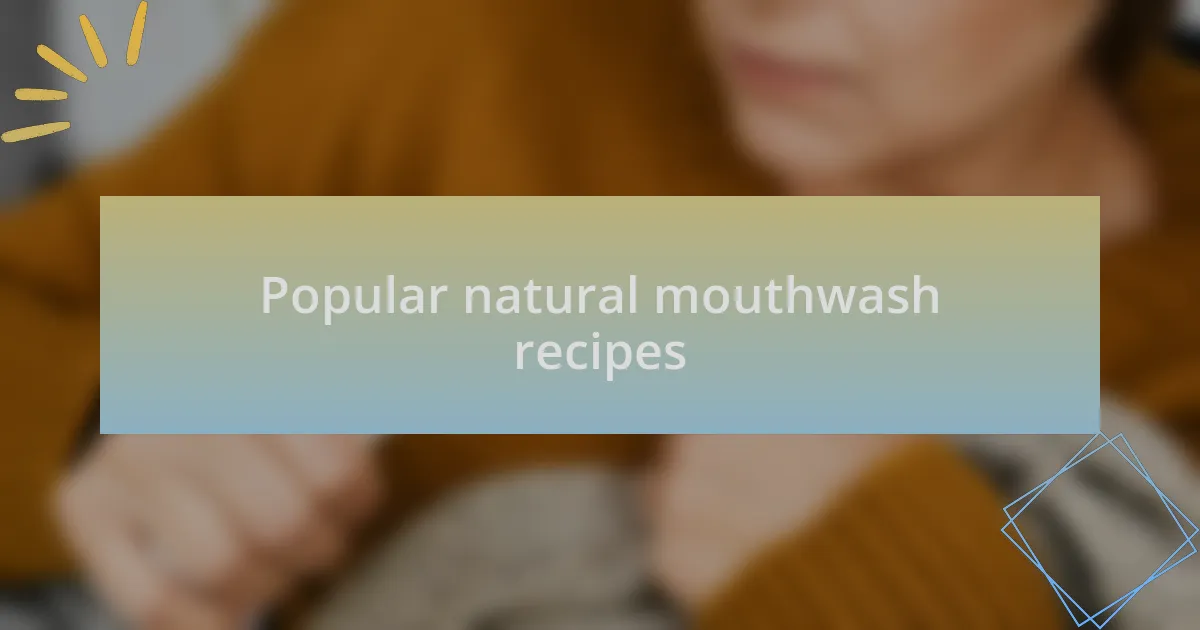Key takeaways:
- Natural mouthwash can improve oral hygiene with simple, recognizable ingredients while promoting overall well-being.
- Key ingredients like baking soda, essential oils, and honey can enhance mouthwash effectiveness and flavor.
- Personalizing mouthwash recipes with fresh herbs and allowing them to steep can create a rewarding self-care ritual.
- Proper storage in glass containers and refrigeration can preserve the quality and benefits of homemade mouthwash.

Understanding natural mouthwash benefits
Natural mouthwash offers several benefits that often get overlooked. For instance, when I first began using a homemade mint-basil mouthwash, I not only noticed fresher breath but also a significant reduction in plaque buildup. Isn’t it amazing how simple ingredients can enhance oral hygiene?
One of the most rewarding aspects of using natural mouthwash is the absence of synthetic chemicals. I remember the first time I read the ingredient label on a commercial mouthwash; it was eye-opening to see so many unrecognizable substances. Choosing natural alternatives feels empowering, as they usually harness the power of nature without compromising oral health.
Moreover, natural mouthwashes can support your overall well-being. I’ve found that when I use products made from soothing herbs like chamomile or tea tree oil, not only do my gums feel healthier, but I also feel a sense of calm. Isn’t it fascinating how something that promotes dental hygiene can also enhance our emotional state?

Choosing ingredients for mouthwash
When choosing ingredients for a natural mouthwash, it’s essential to focus on those that are both effective and safe. For example, I love adding baking soda to my recipes. It acts as a natural abrasive, helping to remove stains, and I distinctly remember the first time I noticed how much brighter my smile looked after using it regularly. Have you ever tried it?
Incorporating antimicrobial ingredients like essential oils can also significantly enhance your mouthwash. I often use peppermint oil not just for its refreshing flavor but for its ability to combat bad breath and bacteria. The first time I experienced that invigorating sensation, I knew I had found a powerful ally in my oral care routine. What’s not to love about a natural ingredient that gives both a fresh breath and a taste of nature?
Don’t forget about the importance of balancing flavors too. When I experimented with a combination of honey and lemon in my mouthwash, it not only tasted great but also provided added antibacterial properties. It’s a little like finding a perfect recipe; the right mix can elevate your experience while ensuring your mouthwash is as effective and enjoyable as possible. Have you played around with different flavors in your own recipes?

Popular natural mouthwash recipes
One of my favorite natural mouthwash recipes is a simple blend of apple cider vinegar and water. I remember the first time I used it; that tangy kick surprised me! It’s not just about the flavor—apple cider vinegar has wonderful antibacterial properties that help keep my mouth feeling fresh. Have you ever tried a vinegar-based mouthwash? It can be a game-changer.
Another popular recipe I swear by involves mixing coconut oil and baking soda. This combination created a creamy, slightly gritty mouthwash that felt surprisingly luxurious. As I swirled it around my mouth, I couldn’t help but feel like I was pampering myself. The antibacterial benefits of coconut oil are well-known, and knowing that it’s working hard to fight off harmful bacteria makes the experience even more satisfying.
I have found that infused herbal mouthwashes, like one made with chamomile and sage, bring a calmness to my oral hygiene routine. The soothing aroma enhances my overall experience, allowing me to take a moment for self-care. Have you considered using herbs for their unique flavors and benefits? They truly can transform a mundane task into a delightful ritual.

Creating your herbal mouthwash
Creating your herbal mouthwash can be a deeply personal and rewarding experience. I often find myself experimenting with ingredients from my kitchen herbal garden, like peppermint and rosemary. The first time I combined fresh peppermint leaves with warm water, the invigorating aroma filled my kitchen, making it a little sanctuary. Have you ever had that moment where a simple act, like brewing herbs, turns into a delightful ritual?
When crafting my herbal mouthwash, I focus not just on the taste but on the benefits of each ingredient. For instance, adding a few drops of tea tree oil can amplify the antibacterial power of the mix. I remember one time when I used a blend of elderflower and chamomile; the calming effect was palpable, and it felt as if I was gifting myself a moment of tranquility amidst a busy day.
One tip I love to share is to let your mixture brew for a while before using it. This allows the flavors and beneficial properties to meld beautifully. I often prepare a batch in the evening and let it steep overnight; that anticipation makes each morning feel a little special as I reach for my homemade mouthwash. Have you considered that patience can elevate even the simplest tasks into something extraordinary?

Tips for effective mouthwash use
When using mouthwash, timing can be crucial. I’ve found that swishing for at least 30 seconds gives the solution time to do its work—fighting bacteria and freshening breath. It’s like giving myself just a moment of calm in a rush-filled morning; who wouldn’t want to start the day with a little mindfulness?
Another tip I’ve come to appreciate is to avoid swallowing the mouthwash. It might seem obvious, but in a hurry, I’ve caught myself forgetting! Once, after an overly minty rinse, I remember a sudden realization about the importance of being cautious. Being mindful of this not only protects my health but also ensures the mouthwash can keep doing its job effectively.
Don’t forget that proper storage makes a difference too. I keep my herbal mouthwash in a cool, dark place to preserve its properties. Rethinking how I store things has become a small yet impactful part of my routine, and I often wonder: how many benefits are lost simply because of neglect? Ensuring my mouthwash is well-preserved feels like a simple commitment to my oral health that pays off every time I reach for it.

Personal favorite mouthwash recipes
When it comes to mouthwash, I have a soft spot for a simple blend of warm water, salt, and baking soda. The first time I tried this recipe, I was amazed at how soothing it felt on my gums. It was like a little spa treatment for my mouth, and I couldn’t believe how well it helped reduce inflammation after a long week of stress.
Another favorite of mine features essential oils like peppermint and tea tree oil mixed with distilled water. The first time I swirled this concoction in my mouth, I experienced an invigorating freshness that lingered long after. I distinctly remember feeling more uplifted, and I wondered: can oral care also elevate our mood? I think it absolutely can!
Lastly, I have a go-to herbal mouthwash that combines green tea, citrus peel, and honey. After a friend introduced me to this recipe, I found myself brewing fresh batches every week. There’s something incredibly satisfying about preparing something so natural and knowing it’s making a positive impact on my dental health. Plus, every time I use it, I can’t help but smile, recalling those warm afternoons spent experimenting in the kitchen.

Storing and preserving mouthwash recipes
When it comes to storing homemade mouthwash, I always use glass containers. Why glass? Because it keeps the ingredients fresh and helps avoid any chemical leaching that can occur with plastic. I remember the first time I stored a minty mouthwash in a mason jar; I was surprised at how well it preserved the flavor for several weeks.
For longer-lasting mouthwash, refrigeration is key. I like to make small batches that can fit in my fridge easily, ensuring I have a fresh mix every week. There’s something so rewarding about taking that chilled jar out and knowing it’s packed with vigor and natural goodness, ready to revitalize my oral hygiene routine.
It’s important to remember that oil-based mouthwashes should be kept in darker containers to protect them from light, which can degrade their quality. I found this out the hard way after a bright, sunny weekend left my vibrant DIY mouthwash tasting less than fresh. So now, I make it a point to choose a container that not only looks good but also does its job in preserving my precious concoctions.